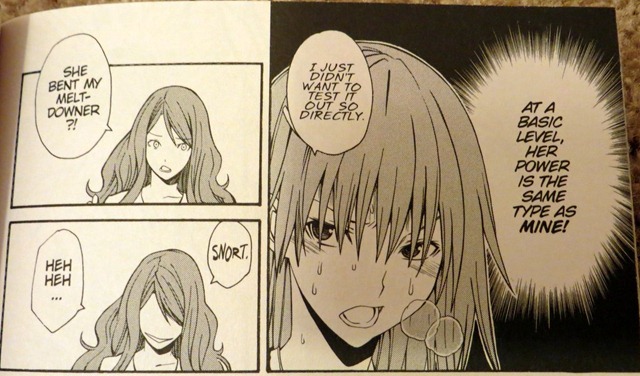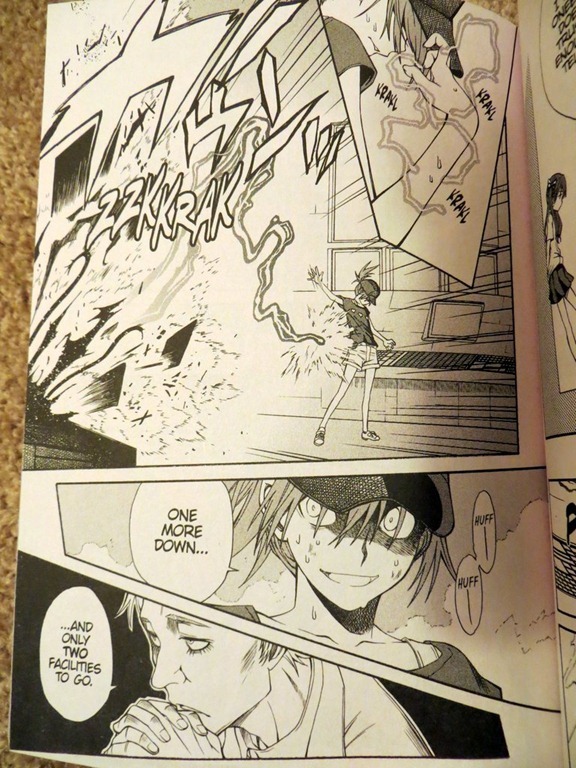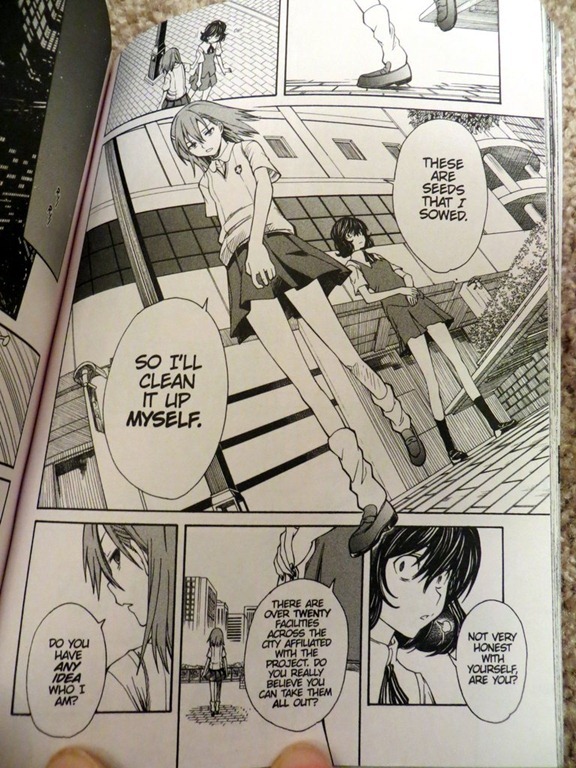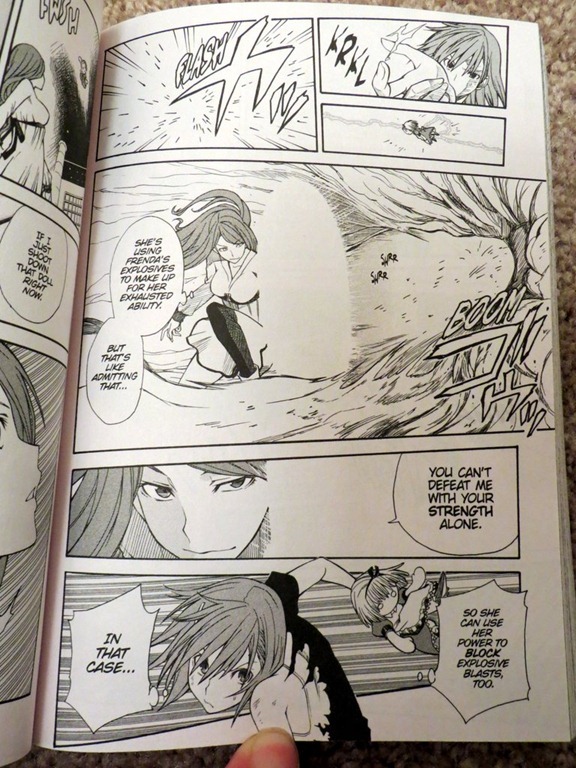Storytellers: Story by Kazuma Kamachi, art by Motoi Fuyukawa
Publisher: Seven Seas Entertainment
Year of Publication: 2010
Page Count: Approximately 175 pages
What I learned about Writing/Storytelling:
1. One of a writer’s most important jobs is finding an interesting way to tell a scene, this is possibly their most important job. I want to demonstrate with a four page excerpt from A Certain Scientific Railgun.
Here’s some background on the story: our heroine is a girl named Misaka, who carries the nickname “The Railgun”. She has power over electricity, which means, among other things, she can move metal like Magneto or Static. In this volume, she’s broken into a laboratory facility with the goal of stopping science experiments on human subjects. The scientists, expecting her arrival, have hired a team of female assassins to stop her. One of the assassins has booby trapped the place with bombs.
In this sequence, Misaka is crossing a stairway over a chasm, and the booby trap goes off: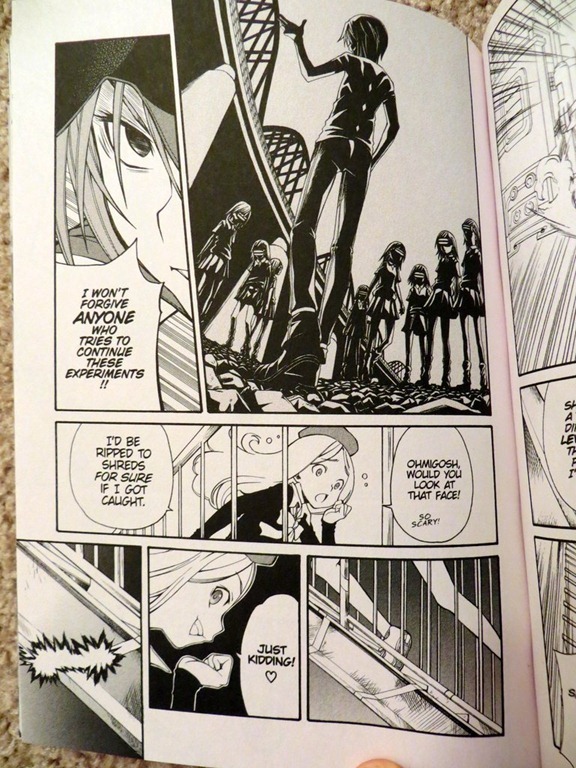
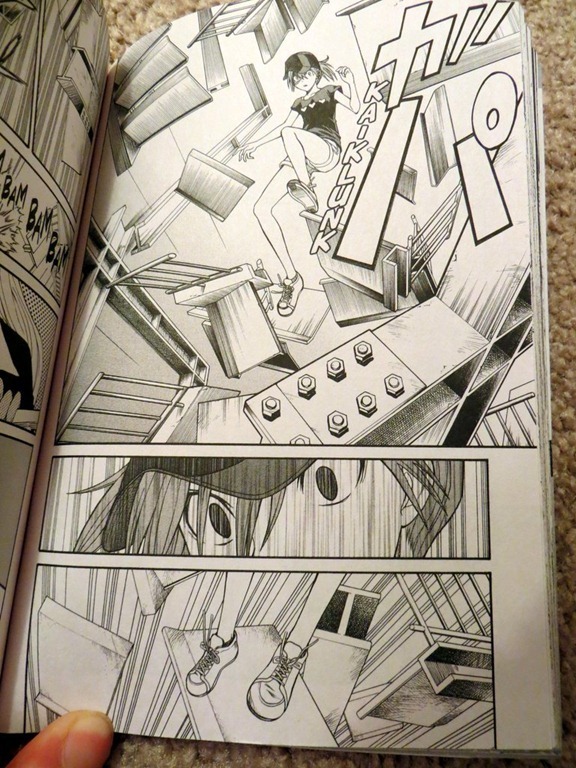
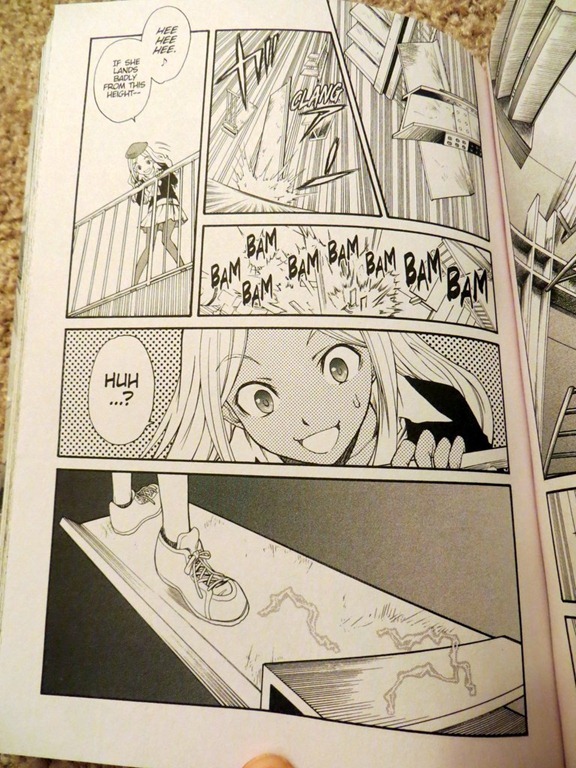
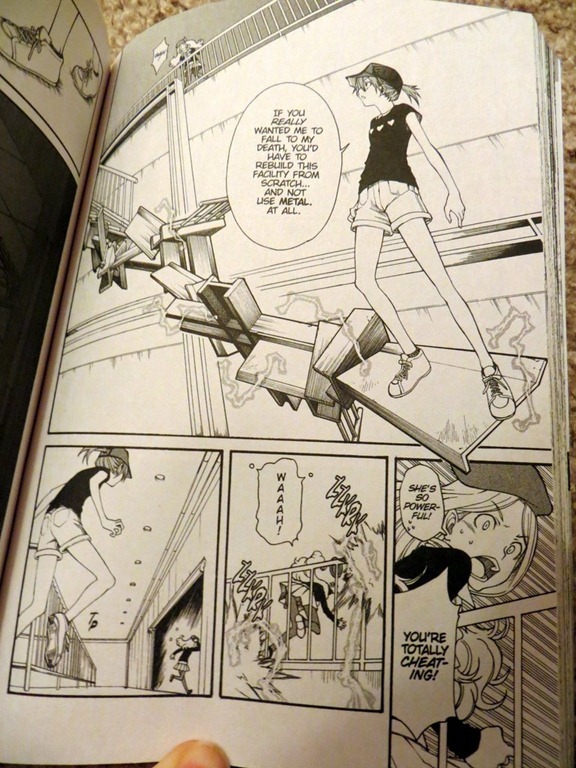
What’s interesting here is it shifts perspective from the hero to the villain. We begin with the perspective of the hero is in pursuit of the bad guy. Point of view shifts to the bad guy, waiting for her trap to go off. As it goes off, we shift back to the hero, surprised at the trap. Shift to the villain, pleased with herself as the trap goes off. She hears some metal pieces crashing onto the ground, and assumes her trap has worked. We stay with her as she is shocked to learn that the hero has survived. By shifting perspective, the creative team has discovered an interesting way to tell the event.
What a lesser writer might have done is stick with the hero throughout the scene, maybe have some sort of thought bubble over her head “Oh no, a trap has gone off…. if I can just use my control of electricity to magnetize the metal…..” That would be serviceable to communicate what is happening, but be lacking in drama. By changing the point of view, we follow the character having the most dramatic reaction at any given moment in time. If things are more dramatic from the villain’s POV, go there.
You can even shift perspective on the same page, as they do in this sequence, as the hero and a supervillain realize they have similar superpowers:
Incidentally, this shows a seemingly RANDOM switch between thought balloons (or whatever you call those shiny manga things) and spoken out loud dialogue. I’ve thought about it, and I figure what is happening is that the artist simply chooses whichever type of balloon he feels blends with the art at any given moment. Internal monologue and speaking out loud are seemingly interchangeable for this type of scene.
This style is pretty much as far from the formalism of my favorite writers, Alan Moore, as possible. While Moore and his collaborators are concerned with structure and consistency, meticulously creating a story out of a specific set of devices, A Certain Scientific Railgun has a more relaxed approach to storytelling. “Does the thought bubble look better here than the narrative box? Ok, draw it that way!”
if you dig deeper, however, there are some similarities in terms of craft. A big part of Alan Moore’s style is elaborate set ups for scene to scene transitions. This book sometimes sets up transitions as well, but it doesn’t draw attention to what it’s doing the way a device like a close up on a puddle with a reflection of a sign that mirrors the black freighter logo of a comic within the comic, or whatever:
After destroying a bad guy’s facility, she says “One more down…” but the sentence is continued by the bad guy in the next scene, saying “… and only two facilities to go.” So, there’s definitely narrative tools being used here here, but it’s a more relaxed, less showy sort of craft.
One notable thing about the page above is it uses the last panel to start the next scene. Moore virtually always shifts on the page turn, and most other writers seem to do it that way as well, so this is a bit unusual from an American comics perspective.
Here’s another example of an author picking a dramatic “hook” for a scene:
How would a lesser writer depict this scene? They’d probably have the hero say something banal like “I’m off to save the day!” A mediocre artist might give us a grid of identically shaped panels with paint by numbers long shots.
This team team makes things interesting by giving us a BIG heroic strut and this badass exchange:
“Do you really believe you can take them all out?”
“Do you have any idea who I am?” (The response makes sense if you are aware that the main character is one of the most powerful super powered people in the world of the story.)
One final page: Check this out:
The climactic battle in this volume plays out like a tennis match, with the hero and villain shooting powers back and forth. Both characters are perfectly matched. In this page, Misaka lobs a doll containing a bomb at the villain, the villain disables it with her blast power, Misaka acknowledges this and prepares to try a different move. The person who is gaining the upper hand goes back and fourth during the battle. Thoughts are used to show the emotional reactions of the characters, but not to give out what move they plan to do next.
I don’t recall reading long, extended, strategic badass scenes like this in American comics.
Some observations about the art:
1. When composing the panel, there is no requirement to show the whole head. As long as you get at least an eye in shot, you seem to be good. Look at the four page booby trap sequence above: Page 1 panel 2 of the sequence shows less than the whole face in order to get a BIG image to the right. The artists seems to do this a lot, small partial head shots in order to get room for BIG PANELS that convey dramatic action. These partial head views have the added benefit of providing variety, but the artist makes sure to give us the long shot images that show where the characters stand in physical space in relation to each other as well.
2. Close up shots with a changed texture (often dots, sometimes lines) are used to signify emotion, usually shock or surprise. You see this on the booby trap sequence on page 2 panel 2 or page 3 panel 4.
Recommendation: A
Notes/Reviews/Synopsis:
This comic is absolutely not for everyone. For one thing, it’s can get pervy at times, in the way that only manga can. Its a mixed genre book that has plotlines that do not always contain a solid amount of action or adventure. There’s a good review of volume 1 of the series, discussing its pervy aspects, here.
That said, I like it, and for the masterful craftsmanship on display here, I give Railgun volume 5 an ”A”.
